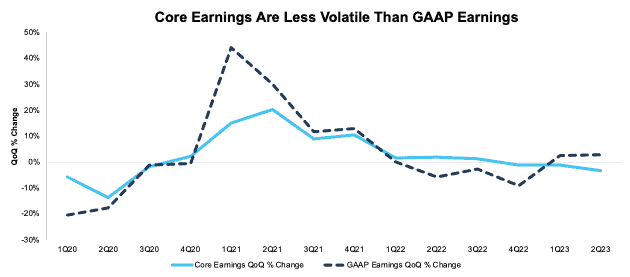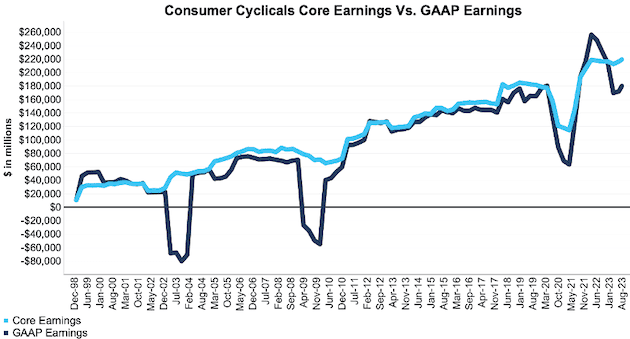Seeing GAAP Earnings move in the opposite direction of Core Earnings raises red flags about the quality of reported earnings while also raising the risk of earnings misses in subsequent quarters. In other words, 3Q23 and 4Q23 earnings seasons could be ugly. These results underscore the more stable nature of Core Earnings. Because we remove unusual gains and losses, Core Earnings are not prone to the large swings seen in GAAP Earnings.
This report is an abridged and free version of All Cap Index & Sectors: GAAP Earnings’ Misleading Trend Continues in 2Q23, one of our quarterly reports on fundamental market and sector trends.
The full version of the report analyzes Core Earnings[1][2] and GAAP earnings of the NC 2000 and each of its sectors (last quarter’s analysis is here) from 1998 to present. The full reports are available to Professional and Institutional members.
This report leverages our cutting-edge Robo-Analyst technology to deliver proven-superior fundamental research and support more cost-effective fulfillment of the fiduciary duty of care.
GAAP Earnings Again Misleading in 2Q23
Our superior fundamental data protects investors from being misled by false trends in un-scrubbed GAAP Earnings. The recent movement in GAAP Earnings, which we first highlighted in 1Q23, explains part of Wall Street’s recent bullishness and our bearishness on certain stocks. Looking beyond the headlines reveals that the recent rise in GAAP Earnings may be an illusion for three reasons:
- Understated GAAP earnings in prior quarters set up easy comps. The kitchen sink effect in full effect.
- Unusual gains are artificially elevating GAAP Earnings and cannot persist forever.
- Core Earnings heading lower suggests GAAP Earnings will normalize and do the same soon.
If the trend in GAAP Earnings proves to be an illusion, investors could be in for a rude awakening in the second half of 2023, especially if they’ve been investing in expensive stocks. See Figure 1 in the full report.
Core Earnings Are Less Volatile than GAAP Earnings
Figure 1 in the full report shows GAAP Earnings for the S&P 500 meaningfully differ from Core Earnings. Corporate profits, as measured by Core Earnings, have been much less volatile than GAAP earnings suggest, especially since 1Q20. For example, per Figure 1, in the TTM ended:
- 1Q21, GAAP earnings: +44% QoQ versus +15% for Core Earnings.
- 2Q22, GAAP earnings: -6% QoQ versus +2% for Core Earnings.
- 3Q22, GAAP earnings: -3% QoQ versus + 1% for Core Earnings.
- 4Q22, GAAP earnings: -9% QoQ versus -1% for Core Earnings.
- 1Q23, GAAP earnings: +2% QoQ versus -1% for Core Earnings.
- 2Q23, GAAP earnings: +3% QoQ versus -3% for Core Earnings.
Figure 1: NC 2000 Core Earnings Vs. GAAP Earnings QoQ Percent Change: 1Q20 – 2Q23
Sources: New Constructs, LLC and company filings.
Our Core Earnings analysis is based on aggregated TTM data for the sector constituents in each measurement period.
The August 15, 2023 measurement period incorporates the financial data from calendar 2Q23 10-Qs, as this is the earliest date for which all of the calendar 2Q23 10-Qs for the NC 2000 constituents were available.
GAAP Earnings Understate Core Earnings for Nearly Two-Thirds of the NC 2000 (by Market Cap)
For the TTM ended 2Q23, 60% of the companies in the NC 2000 reported GAAP Earnings that are lower than Core Earnings.
When GAAP Earnings are lower than Core Earnings, they are understated by an average of 250%, per Figure 2. GAAP Earnings understated Core Earnings for 1,196 companies in 2Q23, compared to 1,242 in the TTM ended 1Q23.
Figure 2: NC 2000 GAAP Earnings Understated by 250% On Average
Sources: New Constructs, LLC and company filings.
We use Funds from Operations (FFO) for Real Estate companies rather than GAAP Earnings.
Key Details on Select NC 2000 Sectors
The Utilities sector saw the largest QoQ improvement in Core Earnings, which rose from $49.5 billion in 1Q23 to $52.4 billion in 2Q23, or 6%.
At $451.8 billion, the Technology sector generates the highest Core Earnings and saw Core Earnings rise 2% QoQ in 2Q23. On the flip side, the Real Estate sector has the lowest Core Earnings at $29.8 billion, which fell 1% QoQ in 2Q23.
Below we highlight the Consumer Cyclicals sector and a stock with some of the most negative Earnings Distortion (i.e. understated GAAP earnings) in the sector.
Sample Sector Analysis[3]: Consumer Cyclicals Sector
Figure 3 shows Core Earnings for the Consumer Cyclicals sector, at $219.5 billion, rose 1% QoQ in 2Q23, while GAAP earnings, at $180.2 billion, rose 5% over the same time.
Figure 3: Consumer Cyclicals Core Earnings Vs. GAAP: 1998 – 2Q23
Sources: New Constructs, LLC and company filings.
Our Core Earnings analysis is based on aggregated TTM data for the sector constituents in each measurement period.
The August 15, 2023 measurement period incorporates the financial data from calendar 2Q23 10-Qs, as this is the earliest date for which all of the calendar 2Q23 10-Qs for the NC 2000 constituents were available.
GAAP Earnings Understatement Details: General Motors (GM)
Below, we detail the hidden and reported unusual items overlooked in GAAP Earnings and captured in Core Earnings for General Motors (GM). After adjusting for unusual items, we find that General Motors’ Core Earnings of $12.0 billion, or $8.43/share are much higher than reported GAAP Earnings of $10.2 billion, or $7.17/share.
General Motor’s Stock Rating is Very Attractive, in part due to its positive economic earnings, high free cash flow yield, and low price-to-economic book value (PEBV) ratio of 0.3. We made General Motors a Long Idea in March 2018, and while the stock has underperformed, it remains highly undervalued. See all our research on General Motors here.
Below, we detail the differences between Core Earnings and GAAP Earnings so readers can audit our research.
Figure 4: General Motors’ GAAP Earnings to Core Earnings Reconciliation: TTM through 2Q23
Sources: New Constructs, LLC and company filings.
More details:
Total Earnings Distortion of -$1.26/share, which equals -$1.8 billion, is comprised of the following:
Hidden Unusual Expenses Pre-Tax, Net = -$1.36/per share, which equals -$1.9 billion and is comprised of:
- -$1.5 billion in hidden restructuring expenses in the TTM period based on
- -$246 million in Buick dealer strategy charges on page 29 in 2Q23 10-Q
- -$875 million in voluntary separation program charges on page 26 in 1Q23 10-Q
- -$99 million in Buick dealer strategy charges on page 26 in 1Q23 10-Q
- -$256 million in restructuring and other initiatives in the TTM based on $511 million charge on page 90 in the 2022 10-K
- -$1 million impairment charges in 4Q22 based on -$12 million impairment charge on page 72 in 2022 10-K
- -$529 million in cruise compensation modifications based on -$1.1 billion charge on page 27 in the 2022 10-K
- $76 million benefit from GM Korea wage litigation no page 29 in the 2Q23 10-Q
Reported Unusual Expenses Pre-Tax, Net = -$0.06/per share, which equals $79 million and is comprised of:
- -$542 million in other expenses in the 2022 10-K
- $1.5 billion in interest and other non-operating income in the TTM period based on
- $358 million in 2Q23
- $409 million in 1Q23
- $102 million in 4Q22
- $598 million in 3Q22
- $238 million in licensing agreements income in 2022 10-K
- -$236 million in revaluation of investments in 2022 10-K
- $1.0 billion contra adjustment for recurring pension costs. These recurring expenses are reported in non-recurring line items, so we add them back and exclude them from Earnings Distortion.
Tax Distortion = $0.16/per share, which equals $225 million.
This article was originally published on August 29, 2023.
Disclosure: David Trainer, Kyle Guske II, Italo Mendonça, and Hakan Salt receive no compensation to write about any specific stock, style, or theme.
Questions on this report or others? Join our Society of Intelligent Investors and connect with us directly.
Appendix: Calculation Methodology
We derive the Core Earnings and GAAP Earnings metrics above by summing up the trailing-twelve-month individual NC 2000 constituent values for Core Earnings and GAAP Earnings in each sector for each measurement period. We call this approach the “Aggregate” methodology.
The Aggregate methodology provides a straightforward look at the entire sector, regardless of market cap or index weighting and matches how S&P Global (SPGI) calculates metrics for the S&P 500.
[1] Core Earnings enable investors to overcome the flaws in legacy fundamental data and research, as proven in Core Earnings: New Data & Evidence, written by professors at Harvard Business School (HBS) & MIT Sloan for The Journal of Financial Economics.
[2] Based on the latest audited financial data, which is the 2Q23 10-Q in most cases. Price data as of 8/15/23.
[3] The full version of this report provides analyses for all eleven sectors.




